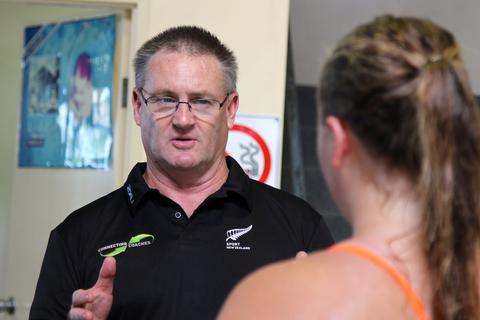Don’t Count the Repeats:Make the Repeats Count.

I know, I know, I know.
This sounds like an advertisement for a new sporting product or new piece of sporting training equipment…the sporting equivalent of the “knife that cuts through a shoe” or the “miracle mop” that does everything around the house including walking the dog, cooking dinner and putting the kids to bed.
But no….this is serious. You can achieve More with Less…this is how to do Less but get a Better result.
Three Ways to Do it….more, more, more.
There are three ways of doing things: three basic ways of approaching training, preparation and coaching in sport:
- The More Way: Train hard.
- The More with More Way: Train harder.
- The More with Less Way: Train smarter.
But let’s define “smarter”.
Let’s start with a sport like Tennis.
The More way of doing things: “Let’s hit a bucket of balls across the net”.
The More with More way of doing things: “Let’s hit two buckets of balls across the net”.
And the More with Less way of doing things: “Let’s be totally engaged with the training task of hitting balls across the net, lets focus on each ball we hit and challenge ourselves physically and technically in some way every time we hit a ball”.
The Mathematics of Mediocrity:
The aim of all training in competitive sport is to prepare athletes to perform to their full potential in competition or, if you like, to train the way you want to play!
So go back to our Tennis example.
Let’s say there are 100 balls in the bucket. And I hit 100 balls over the net. And of that 100 balls I hit over the net, my mind is only fully engaged with 10 of them. So, in terms of how my training relates to my competition that’s a success rate of………10%.
Now convert a 10% success rate to an actual Match situation. You l.o.s.e.
If however I have another bucket containing just 10 balls and I hit those 10 balls over the net with the same focus, concentration, passion, intensity and engagement that I use in competition…..what’s the success rate?
100%!!!!! and anyone who has a 100% success rate in a Match can start booking a flight to Wimbledon or Flushing Meadows. You are going to the top.
Don’t Count the Repeats: Make the Repeats Count.
This is the critical concept of the More with Less philosophy. Doesn’t matter if it is swimming laps, catching baseballs, throwing footballs, shooting baskets, shooting pucks….it is all the same principle…..don’t count the repeats: make the repeats count.
Doing more, in itself is not the answer. Just increasing training volume (i.e. how much you do) is not going to give you the results that you think it will.
Doing less but with complete, total physical and mental engagement in the task is the answer.
And now the Punchline……
So right now, some of you are probably reading this and thinking, “So this guy is telling me success is easy, to work less and there is a quick way to get to the top”.
Wrong.
Nothing could be further from the truth.
The More with Less philosophy is actually harder, more challenging and more demanding than the traditional “More” and “More with More” methods because of the level of athlete and coach engagement required.
There are no “free” hits in the More with Less philosophy.
There are no “easy” repeats.
There are no “sloppy efforts”
No more mindless miles, senseless sets, pointless practices or wasted weights-sessions. It’s about efficiency, effectiveness, enjoyment and excellence through engagement.
For the More with Less philosophy to work, your athletes need to be more attentive, more “on-line”, more switched on and more engaged than ever before.
For the More with Less philosophy to work, you need to coach better than you have ever coached in your entire life: you need to be more engaged than even your most engaged of your athletes.
And the Future?
At a time when coaches, parents and indeed sports are grappling with how to make their “product” – i.e. their sport, more attractive to young athletes: young athletes who are “lazy” and who get easily bored and distracted when exposed to traditional training methods, the More with Less philosophy offers some real possibilities for the future.
The best of news of all is, that you can, without spending a cent (or a dinar or a drachma or whatever currency you use), without buying any new miracle products, without building any new facilities or purchasing any new equipment, achieve more with less.
Wayne Goldsmith



6 Comments
Thom · February 20, 2011 at 8:44 am
I couldn’t agree more!
I have just ended my coaching association with a development program in Rugby League in Brisbane, because they have this more from more attitude.
They believe that 15 year olds training for 3 hours at a time is effective, and if they lose interest, the attitude is “they were never meant to be elite”.
I would even say that 10% quality from the three hour sessions would be the tops! They may have achieved this early on, but as the pre-season progressed, the players grew less and less engaged.
These boys have been in this program since September (no break at the end of last season). Last night was their first trial match and they could not hold a football.
They are burned out before the season has even started yet the program managers hold their program as important above all else! (This reminds me about your previous post discussing who owns sport).
The worst part of all of this is that the players are not interested in playing at the highest level for their age. The introduction they have been given to the senior ranks, and “elite” sport is that there is no fun.
Rugby League is LUCKY to have the participation levels it traditionally enjoys, and if things don’t change in the administration of these programs, the participation levels will.
EMBRACE THE GEN Y ATHLETE!!!
(BTW I have a new role in a different club and am much happier)
Wayne Goldsmith · February 20, 2011 at 9:24 am
Thanks Thom.
The “more with more” coaching philosophy is actually lazy coaching.
Coaches who believe that all they have to do to be succesful is increase volume – to be honest – have no idea.
If the competition environment is about excellence at speed, under fatigue and under pressure, if it is about making great decisions when it counts, if it is about maintaining outstanding technique and skills in high pressure situations, how then does doing more work at slow speeds with mediocre skills and technique achieve anything?
I have heard the old “if they can’t do 3 hours of training they will never be elite” stuff for 20 years and it is rubbish.
I would turn it around and say, “If you can’t engage the hearts and minds of your athletes for 30 minutes so that every moment is performed with the same (or greater) intensity, focus, concentration, skill level, speed and decision making as you want to achieve in a game, you will never be an elite…..coach”.
Thanks,
WG
david · February 27, 2011 at 2:11 am
G’day WG,
Cool website mate, it’s now bookmarked, found you on twitter fyi.
Quality over quantity, with regards to physical movement.
It just makes sense, too much quantity creates higher risk of too much over reaching, creates too much fatigue – thereby lowering quality, inevitably too much quantity lowers performance, this is known. See Emma Carney and what too much quantity did to her performance and ultimately her heart and health, for just one example.
The mind body state must be in balance for peak performance, the body isn’t so worn out by quantity that it’s detrimentally affecting the mind, instead the body is a fresh weapon that is synergizing with the mind to create high quality output.
It’s our role as coaches to help the athlete find that balance, when they find it, we’ll know, because our jaw drops and our heart sings for the athlete.
Wayne Goldsmith · February 27, 2011 at 1:58 pm
Thanks David.
There is an old thing about endurance athletes which goes, “why do they train so hard” and the reply is “because they can”.
Doing lots of long, meaningless miles is not the challenge: that’s just drive, commitment, some time management and a little determination.
Ensuring every session is specifically tailored to provide the best possible environment for each individual athlete to prepare to their full potential is the real challenge.
A lot of coaches say they are “tough” just because they force athletes to do large volumes of training.
Rubbish!
I have seen many, many mediocre performances from athletes who have trained “tough”. Huge volumes of training are not the solution.
A “tough” coach expects and demands an uncompromising approach to every aspect of training, preparation and competition: one where the athlete is totally engaged in every moment – physically and mentally.
Mind-body balance is critical isn’t it.
It is amazing how many athletes I know who have been among the best in the world yet are what I would term “mentally-fragile”: i.e. they are incredibly well prepared physically and rely on their fitness to give them the confidence to race well.
But….if something goes wrong with their physical preparation…they have nothing left.
Thanks again,
WG
Ridaa Ismail · April 15, 2011 at 5:28 pm
Hi Wayne,
I can definitely relate to this post. A year ago I was appointed as Head Coach of an U16 side at one of South Africa’s top sporting schools. Up until that point they hadn’t won a game yet they had the skill but little to no fitness.
I decided to implement a form of interval training where I would push the players to sprint at near max effort for 50m and jog for 50m (they would get 40secs to complete one set), basically from tryline to tryline for about 12-15 sets, depending on the time of the season (Pre-season, In-season etc.). Other coaches smirked and made their boys do “laps” the traditional way saying the only way they can be fit is by jogging 10k’s every day etc.
At the end of the day my team had a win rate of 90% and were generally the fittest team in arguably the toughest schools rugby league in the world… all this with about 8 mins every practice. The other coaches were scrambling to copy my training as if it was some secret supercharge session. I sat and watched them and almost all of them neglected the sprint interval altogether, making the boys jog at 60% effort rather than push them to the max.
In essence what they were looking for was a shortcut and their boys remained relatively as unfit as when they began!
Also I ensured there was a time limit and I also ensured that they HAD to jog during the “rest” interval meaning that they were forced to engage themselves at max. effort during the sprint interval to make it in 40 seconds.
Thanks for the outstanding work, always look forward to coming to your site.
Ridaa
Wayne Goldsmith · April 19, 2011 at 10:06 am
Thanks Ridaa,
Sounds like an interesting approach and the one thing I know for certain, is the copying kills. The surest way to lose anything is to copy what everyone else is doing. So good work for “daring to be different”.
When I was working for a professional rugby team a few years ago we did GPS analysis of players during games and found out that a lot of the time – almost 90% of the time in actual games – players are walking, striding or moving relatively slowly.
We also found that players in the same positions cover different distances during games based on their ability to read the game and their understanding of positional play.
The key finding was – surprise – surprise – understand the way each player plays the game and condition them as individuals to play the game to their full potential.
Thanks again,
WG